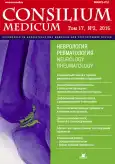Алгоритм ведения пациентов с подозрением на статининдуцированную миопатию (клинический случай тяжелой врожденной миопатии, развившейся на фоне длительного приема статинов)
- Авторы: Деева Т.А.1, Драпкина О.М.1
-
Учреждения:
- Клиника пропедевтики внутренних болезней, гастроэнтерологии и гепатологии им. В.Х.Василенко ГБОУ ВПО Первый МГМУ им. И.М.Сеченова Минздрава России
- Выпуск: Том 17, № 2 (2015)
- Страницы: 21-26
- Раздел: Статьи
- URL: https://journals.rcsi.science/2075-1753/article/view/94218
- ID: 94218
Цитировать
Полный текст
Аннотация
Полный текст
Открыть статью на сайте журналаОб авторах
Татьяна Андреевна Деева
Клиника пропедевтики внутренних болезней, гастроэнтерологии и гепатологии им. В.Х.Василенко ГБОУ ВПО Первый МГМУ им. И.М.Сеченова Минздрава России
Email: deeva_ta@mail.ru
соискатель каф. пропедевтики внутренних болезней ГБОУ ВПО Первый МГМУ им. И.М.Сеченова 119435, Россия, Москва, ул. Погодинская, д. 1, стр. 1
Оксана Михайловна Драпкина
Клиника пропедевтики внутренних болезней, гастроэнтерологии и гепатологии им. В.Х.Василенко ГБОУ ВПО Первый МГМУ им. И.М.Сеченова Минздрава России
Email: drapkina@yandex.ru
д-р мед. наук, проф. каф. пропедевтики внутренних болезней лечебного факультета ГБОУ ВПО Первый МГМУ им. И.М.Сеченова 119435, Россия, Москва, ул. Погодинская, д. 1, стр. 1
Список литературы
- Национальный доклад. Под ред. акад. РАМН Л.А.Бокерия, акад. РАМН Р.Г.Оганова. М.: НЦССХ им. А.Н.Бакулева РАМН, 2010.
- Драпкина О.М., Деева Т.А. Статины и фиброз. Есть ли связь? Справ. поликлин. врача. 2011; 7: 15-7.
- Драпкина О.М., Клименков А.В., Ивашкин В.Т. Можно ли назначать статины пациентам с патологией печени? Справ. поликлин. врача. 2007; 5 (5).
- Marcoff L, Thompson P.D. The role of coenzyme Q10 in statin - associated myopathy: a systematic review. J Am Coll Cardiol 2007; 49 (23): 2231-7.
- Littarru G.P, Langsjoen P. Coenzyme Q10 and statins: biochemical and clinical implications. Mitochondrion 2007; (Suppl. 7): S168-74.
- Драпкина О.М., Чернова Е.М., Корнеева О.Н. Статины и миопатия: молекулярные механизмы. Рацион. фармакотерапия в кардиологии. 2012; 8 (3).
- Аронов Д.М. Cтатины: вопросы безопасности и переносимости. Справ. поликлин. врача. 2005; 3 (2).
- Thompson P.D et al. JAMA 2003; 289 (13): 1681-90.
- Escobar C, Echarri R, Barrios V. Vasc Health Risk Manag 2008; 4: 525-33.
- Sathasivam S, Lecky B. Statin induced myopathy. BMJ 2008; 337: a2286.
- Евтушенко С.К. и др. Окулофарингеальная миодистрофия. Научный обзор и описание клинического случая поздней диагностики заболевания у взрослого пациента. Междунар. неврол. журн. 2011; 7 (45).
- Всероссийское научное общество кардиологов. Диагностика и коррекция нарушений липидного обмена с целью профилактики и лечения атеросклероза. Российские рекомендации (четвертый пересмотр). 2009.
- Finegold J.A, Manisty C.H, Goldacre B et al. What proportion of symptomatic side effects in patients taking statins are genuinely caused by the drug? Systematic review of randomized placebo - controlled trials to aid individual patient choice. Eur J Prevent Cardiol 2014. doi: 10.1177/2047487314525531
- Mc Kenney J.M, Davidson M.H, Jacobson T.A et al. Am J Cardiol 2006; 97: 89C-94C.
Дополнительные файлы






